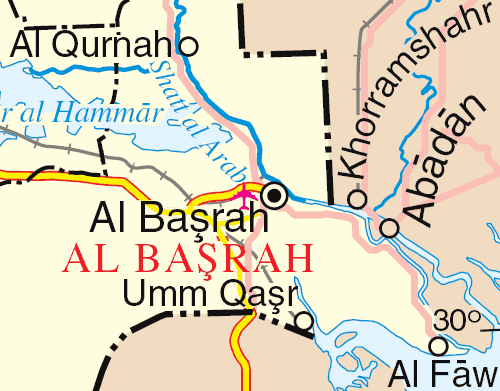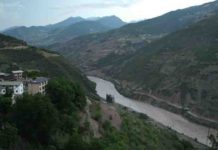Shatt al-Arab is a river in Southwest Asia of some 200 km (120 mi) in length, formed by the confluence of the Euphrates and the Tigris in the town of al-Qurnah in the Basra Governorate of southern Iraq. The southern end of the river constitutes the border between Iraq and Iran down to the mouth of the river as it discharges into the Persian Gulf. It varies in width from about 232 metres (761 ft) at Basra to 800 metres (2,600 ft) at its mouth. It is thought that the waterway formed relatively recently in geologic time, with the Tigris and Euphrates originally emptying into the Persian Gulf via a channel further to the west.
The Karun river, a tributary which joins the waterway from the Iranian side, deposits large amounts of silt into the river; this necessitates continuous dredging to keep it navigable.
The area is judged to hold the largest date palm forest in the world. In the mid-1970s, the region included 17 to 18 million date palms, an estimated one-fifth of the world’s 90 million palm trees. But by 2002, war, salt, and pests had wiped out more than 14 million of the palms, including around 9 million in Iraq and 5 million in Iran. Many of the remaining 3 to 4 million trees are in poor condition.
In Middle Persian literature and the Shahnama (written between c. 977 and 1010 AD), the name اروند Arvand is used for the Tigris, the confluent of the Shatt al-Arab. Iranians also used this name specifically to designate the Shatt al-Arab during the later Pahlavi period, and continue to do so after the Iranian Revolution of 1979.
Territorial disputes
Conflicting territorial claims and disputes over navigation rights between Iran and Iraq were among the main factors for the Iran–Iraq War that lasted from 1980 to 1988, when the pre-1980 status quo was restored. The Iranian cities of Abadan and Khorramshahr and the Iraqi city and major port of Basra are situated along this river.
Control of the waterway and its use as a border was a source of contention between Iran and the predecessor of the Iraqi state since a peace treaty signed in 1639 between the Persian and the Ottoman empires, which divided the territory according to tribal customs and loyalties, without attempting a rigorous land survey. The tribes on both sides of the lower waterway, however, are Marsh Arabs, and the Ottoman Empire claimed to represent them. Tensions between the opposing empires that extended across a wide range of religious, cultural and political conflicts, led to the outbreak of hostilities in the 19th century and eventually yielded the Second Treaty of Erzurum between the two parties, in 1847, after protracted negotiations, which included British and Russian delegates. Even afterwards, backtracking and disagreements continued, until British Foreign Secretary, Lord Palmerston, was moved to comment in 1851 that “the boundary line between Turkey and Persia can never be finally settled except by an arbitrary decision on the part of Great Britain and Russia”. A protocol between the Ottomans and the Persians was signed in Istanbul in 1913, which declared that the Ottoman-Persian frontier run along the thalweg, but World War I canceled all plans.
During the Mandate of Iraq (1920–32), the British advisors in Iraq were able to keep the waterway binational under the thalweg principle that worked in Europe: the dividing line was a line drawn between the deepest points along the stream bed. In 1937, Iran and Iraq signed a treaty that settled the dispute over control of the Shatt al-Arab. The 1937 treaty recognized the Iranian-Iraqi border as along the low-water mark on the eastern side of the Shatt al-Arab except at Abadan and Khorramshahr where the frontier ran along the thalweg (the deep water line) which gave Iraq control of almost the entire waterway; provided that all ships using the Shatt al-Arab fly the Iraqi flag and have an Iraqi pilot, and required Iran to pay tolls to Iraq whenever its ships used the Shatt al-Arab. By the late 1960s, the build-up of Iranian power under Shah Mohammad Reza Pahlavi, who had gone on a gargantuan military spending spree, led Iran to take a more assertive stance in the Near East. In April 1969, Iran abrogated the 1937 treaty over the Shatt al-Arab, and as such, Iran ceased paying tolls to Iraq when its ships used the Shatt al-Arab. The Shah justified his move by arguing that almost all river borders all over the world ran along the thalweg, and by claiming that because most of the ships that used the Shatt al-Arab were Iranian, the 1937 treaty was unfair to Iran. Iraq threatened war over the Iranian move, but when on 24 April 1969 an Iranian tanker escorted by Iranian warships sailed down the Shatt al-Arab, Iraq being the militarily weaker state did nothing. The Iranian abrogation of the 1937 treaty marked the beginning of a period of acute Iraqi-Iranian tension that was to last until the Algiers Accords of 1975.
All United Nations attempts to intervene as mediators were rebuffed. Under Saddam Hussein, Baathist Iraq claimed the entire waterway up to the Iranian shore as its territory. In response, Iran in the early 1970s became the main patron of Iraqi Kurdish groups fighting for independence from Iraq. In March 1975, Iraq signed the Algiers Accord in which it recognized a series of straight lines closely approximating the thalweg (deepest channel) of the waterway, as the official border, in exchange for which Iran ended its support of the Iraqi Kurds. In 1980, Hussein released a statement claiming to abrogate the treaty that he signed, and Iraq invaded Iran. (International law, however, holds that in all cases no bilateral or multilateral treaty can be abrogated by one party only.) The main thrust of the military movement on the ground was across the waterway which was the stage for most of the military battles between the two armies. The waterway was Iraq’s only outlet to the Persian Gulf, and thus, its shipping lanes were greatly affected by continuous Iranian attacks. When the Al-Faw peninsula was captured by the Iranians in 1986, Iraq’s shipping activities virtually came to a halt and had to be diverted to other Arab ports, such as Kuwait and even Aqaba, Jordan. At the end of the Iran–Iraq War both sides agreed to once again treat the Algiers Accord as binding.
Recent conflicts
In the 2003 invasion of Iraq, the waterway was a key military target for the Coalition Forces. Since it is the only outlet to the Persian Gulf, its capture was important in delivering humanitarian aid to the rest of the country, and also to stop the flow of operations trying to break the naval blockade against Iraq. The British Royal Marines staged an amphibious assault to capture the key oil installations and shipping docks located at Umm Qasr on the al-Faw peninsula at the onset of the conflict.
Following the end of the war, the UK was given responsibility, subsequently mandated by United Nations Security Council Resolution 1723, to patrol the waterway and the area of the Persian Gulf surrounding the river mouth. They were tasked until 2007 to make sure that ships in the area were not being used to transport munitions into Iraq. British forces also trained Iraqi naval units to take over the responsibility of guarding their waterways after the Coalition Forces left Iraq in December of 2011.
On two separate occasions, Iranian forces operating on the Shatt al-Arab have captured British Royal Navy sailors who they claim have trespassed into their territory.
- In June 2004, several British servicemen were held for two days after purportedly straying into the Iranian side of the waterway. After being initially threatened with prosecution, they were released after high-level conversations between British Foreign Secretary Jack Straw and Iranian Foreign Minister Kamal Kharrazi. The initial hardline approach was put down to power struggles within the Iranian government. The British marines’ weapons and boats were confiscated.
- In 2007, a seizure of fifteen more British personnel became a major diplomatic crisis between the two nations. It was resolved after thirteen days when the Iranians unexpectedly released the captives under an “amnesty.”
Note : The above story is based on materials provided by Wikipedia











